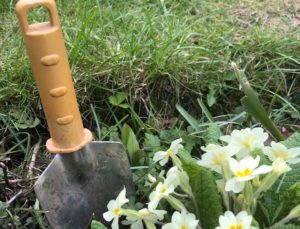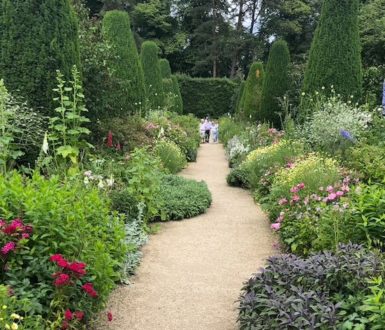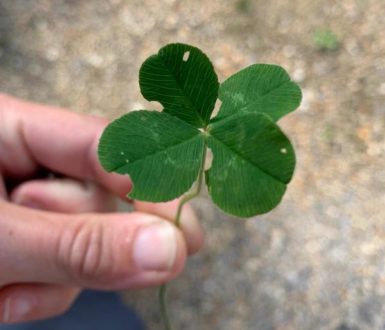A beginner's guide to gardening in Britain

If you have never had a garden before (or you are used to gardening in a different climate), a British garden can seem a bit scary. However, on the positive side, even if you do nothing in your garden something will grow – it’s that easy!
Here is an overview of gardening for total beginners. It might inspire you to become more involved in your garden. Even if it doesn’t, it should help you keep it under control.
The lawn
Grass grows really fast in Britain. From March to November, you might need to cut your lawn 3-4 times a month. If it is really dry, you might only need to cut it once a month. Don’t worry if it goes dead and brown in the summer, it usually comes back to life as soon as there is some rain.
- When you choose a lawn mower, think about how much grass you have. For small gardens, an electric battery lawnmower is usually safest and easiest.
Bushes
Most gardens have some bushy plants. Some bushes grow very fast – the branches grow up to 2 metres per year. Others grow much slower, only a few centimetres. Most will need their branches cut (‘pruned’) to keep them under control.
- As a general rule, prune your bushes in the late autumn. If the plant is evergreen, never cut below the part where the leaves start. If the leaves have fallen off, choose to cut in a place just above a bud. There are lots of detailed guides online. You will need ‘pruning shears’ or ‘secateurs’ and protective gloves.
Trees
Cutting branches from trees is called lopping. You might need a ‘tree surgeon’ to help, especially for anything taller than 2 metres.
- Be aware that some trees are protected by a town planning law called a Tree Preservation Order (TPO). Check with your local council before doing cutting branches on your trees – there can be heavy fines for people who break a TPO.
Plants and weeds
You probably already have plants of some type. But what are they? The first year, don’t do anything right away. Watch the garden over the spring and summer. See what you have. If you like a plant, leave it. If you don’t, dig down and pull it out. Some common weeds (dandelions, for example) are actually quite pretty – as long as you don’t have too many of them. Go online if you want picture galleries of common British weeds.
- Try to leave all plants until you see what their flowers are like because some plants look really boring until then.
Adding plants – basic
There are lots of amazing plants, but many will not grow well in your garden. If you don’t know what to choose, there are some easy ways to find good options. Remember that plants need care for the first year until they grow their roots into your soil. Make sure their soil stays moist.
- Ask for help in your local garden centre – they will understand local soil types and what grows well. It can be helpful to bring a pot of soil to show them.
- If there are some plants in your garden that you like, take a close-up photo of them and show the garden centre or use a plant identifier phone app. There might be other colours/sizes of the same type of plant.
- Get ideas by asking neighbours what grows well in their garden – your garden is probably similar.
- Buy plants from plant stalls at local community events. These are usually cheap and a type of plant that is easy to grow in your area.
Adding plants – advanced
If you are feeling more adventurous about choosing plants, you will need to understand the soil and conditions in your garden.
- Soil pH: do a pH test to find out how acid, alkali or neutral your soil is (you can buy tests in garden centres). Some plants only grow in certain soil pH.
- Soil type: take a pot of soil to your local garden centre and they will be able to tell you if it is sandy/clay/peaty/loamy and if you need to improve it and make it easier for things to grow. The type of soil affects the type of plant that will be happy (including fruit and vegetables).
- Sun and shade: Watch your garden through the day. Which parts get sun? How long for? Which parts never get sun? Some plants need lots of sun, others are happy with full shade.
- Wet and dry: Explore your garden after light rain. Which areas are still dry? Which areas get really boggy? There are not many plants that like very dry soil, or soil that drains badly.
- Space: How much space do you have? Check the final size of the plant you are buying to make sure it won’t get too big or won’t be hidden by other plants.
Special words for plants
There are special words to describe different types of plant. This is confusing at first. Here is a list of some of the most common gardening words.
- Alpine: a low-growing plant that likes places that are like the Alp mountains – well drained and sunny.
- Annual: a plant that only lives 1 year.
- Bedding plants: colourful small decorative plants that are usually used only for 1 season while they are at their best. Great for pots or hanging baskets.
- Bulbs: plants that grow from a bulb. Daffodils and tulips are good examples. Bulb plants often die back after flowering, but may reappear the next year.
- Conifer: a tree or bush with cones. This includes ‘Christmas tree’ type trees (pines, spruce and fir), but also junipers, cypresses and cedars. Some grow fast and very tall (over 30m).
- Climber: climbing plants. Some will climb up things by themselves, others need your help, by tying string around their stems and attaching it to sticks or frames.
- Ericaceous: plants that only like acidic/peaty soil.
- Herbaceous: a plant without woody stems.
- Perennial: a plant that seems to die completely in the winter because all the leaves and stems shrivel up. In fact, it will usually regrow in the spring.
Hardy perennial – can survive frost (temperatures from -1C and below). This is the safest choice.
Half-hardy perennial – can survive a light frost (probably can’t cope with temperatures below -4C)
Tender perennial – can’t cope with frost at all. You will need to shelter it in winter
- Shrub: plants that grow to become a bush. This might be evergreen (keeps its leaves in winter) or deciduous (loses its leaves in winter).



